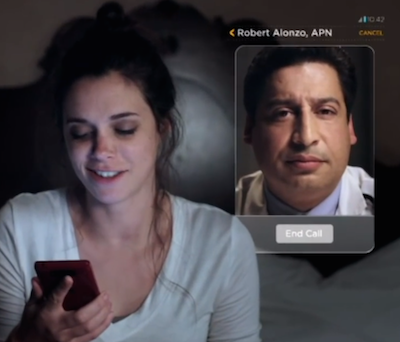 This week Verizon launched a mobile-centric video visits product that physician groups and others can use to provide real-time, remote care to patients. Virtual Visits has been 18 months in the making, Verizon's Director of Mobile Health Julie Kling told MobiHealthNews in an interview, and while it could see integration with Verizon's FDA cleared remote patient monitoring platform in the future, the company shared no immediate plans to do so.
This week Verizon launched a mobile-centric video visits product that physician groups and others can use to provide real-time, remote care to patients. Virtual Visits has been 18 months in the making, Verizon's Director of Mobile Health Julie Kling told MobiHealthNews in an interview, and while it could see integration with Verizon's FDA cleared remote patient monitoring platform in the future, the company shared no immediate plans to do so.
"Our primary customers for Virtual Visits are hospitals and physician groups that are trying to expand their reach beyond bricks and mortar, but [18 months ago] when we first started out, we anticipated it would primarily be health plans," Kling said. "While they are, of course, a key customer too, the risk shifting in healthcare and being transferred from payers to providers" is driving interest in offerings like Virtual Visits among provider groups. Self-insured employers are also showing interest in offerings like this one because they'd like to help keep employees out of the ER for non-emergency issues.
According to Verizon, retail clinics are also showing an interest in offering customers mobile-enabled video visits. Kling found this a bit surprising considering most people live within a few minutes of a retail pharmacy, and the retail clinic trend of a few years ago was partially driven by consumers' need for convenient access to care for more routine medical concerns. Virtual visits are, in many ways, the next generation of an even more convenient medical visit, and as a result they pose a competitive thread to retail clinics.
Verizon isn't the first company to offer up white-labeled video visits to providers and payers. Companies like American Well and Teladoc have been building up customer bases for many years now. Verizon is, however, the biggest company to move into the space, which Kling believes should signal to the market that this type of business is a valid one. Kling said that apart from the credibility, scalability and security capabilities that a large telecom like Verizon could offer, Kling said Virtual Visits is much more mobile-centric than competing services in the market, because its video visits feature runs on 3G/4G cellular as well as WiFi. Some others require users on mobile devices to switch to WiFi for video visits.
"That's one of the things that makes this unique," Kling said. "Of the few companies that do mobile-based virtual visits, most require that you use WiFi to make the calls... Ours is mobile-centric. The mobile experience for the patient is the same as you will see on a tablet or the web. Registration is also going to be available right from the mobile, [while] others require you to sign up on a computer... It really is mobile -- you could be on the train or at the beach, and get the treatment that you need."
Verizon's Virtual Visits can be white-labeled or co-branded by providers and other customers. Kling said that some have requested that Verizon's brand stay attached to the offering since so many consumers are familiar with it. Providers may work with a remote care physicians network that Verizon has a partnership with to provide an after-hours safety net to patients, while using the Virtual Visits offering with their own provider team during normal business hours.
While Kling wouldn't comment on speculation, a big company like Verizon entering the virtual visits space after others have spent so many years building similar businesses, could lead to some consolidation before long.














